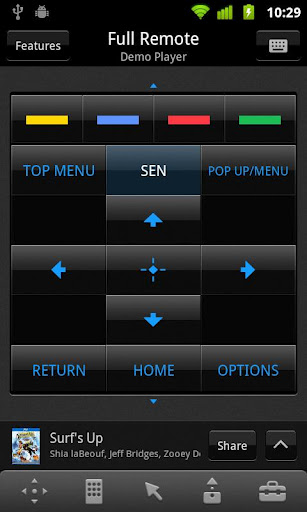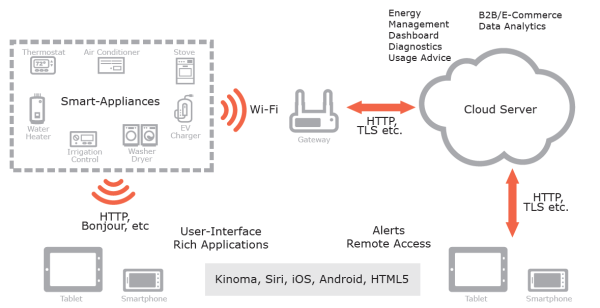Home Automation and the 'Internet of Things'
by Ganesh T S on October 4, 2012 10:30 AM EST- Posted in
- Gadgets
- Home Automation
- Wi-Fi
Technologies such as ZigBee came up in part due to the unsuitability of Wi-Fi, Bluetooth and other such technologies to provide networking with low power consumption, low cost, simplicity and the ability to remain in a suspended state for extended periods of time. Most of the HA technologies were developed when Wi-Fi was unable to satisfy all of these criteria. However, over the last few years, Wi-Fi has slowly, but surely, gained a significant foothold in the home automation industry.
The rise of Wi-Fi's role in home automation has primarily come about due to two factors
- Networked nature of today's electronics: Commonly used electronic devices such as televisions and AV receivers have started becoming part of the home IP network. Even though the networking aspects were added to bring in support for online streaming services or network playback, it became an easy value-add for the manufacturers to expose control of the device functionality over the network.
- Rise of mobile computing devices: The increasing rate of adoption of smartphones and tablets was an added boon. These devices ensure that consumers have access to a portable 'controller' for the electronics connected to the network.
Before proceeding further, I will take a small detour to talk about my personal experience with home automation. Like any other long-time renter, I had no interest in investing money towards fancy home automation solutions. However, as a reviewer of HTPCs and media streamers, I had often used the streamers' Android remotes / XBMC web & Android remote for playback control using my smartphone. I had also installed Sony's remote for my KDL46EX720 TV on my Android smartphone, but rarely got the chance to use it. I realized the full benefit of the Android remote when I found that I could switch on / mute or reduce the volume on the TV without being in the same room.

Sony's Android Remote: Whetting the Appetite for Home Automation
In scenarios such as those outlined above, consumers don't realize that they are actually using some form of HA. The Wi-Fi network already fulfills the basic requirements of a HA system without any extra expenditure on the part of the consumer. For any technology to succeed amongst consumers, price is key. Wi-Fi practically turns out to be free for HA purposes. Hence, it will not be a surprise if home automation with Wi-Fi finally manages to catch the attention of consumers in a way that current technologies haven't been able to.
Addressing Wi-Fi’s Naysayers
We have been through multiple generations of Wi-Fi since the first 802.11-based consumer products appeared in 1999. With maturing technology, the cost of Wi-Fi radios has gone down. They have also become simpler to integrate into systems. At the beginning of this section, we had outlined the reasons as to why ZigBee was developed as an alternative to Wi-Fi for HA purposes. We see that some of these issues have already been addressed. Power consumption and reliable range, however, remain a problem. Towards this, the 802.11 group is working on a new standard, 802.11ah. Expected to be ratified around May 2015, its main purpose is the creation of a sub-1 GHz sensor network. Smart metering is one of the intended applications, but home automation should not be far behind. 802.11ah should help address any shortcomings of current generation Wi-Fi for HA purposes.
Silicon Vendors Target Fast-Growing Market
The primary requirements for the wireless communication modules in these HA devices are:
- Low power MCU integrated in the module along with networking stack
- 802.11 b/g support (802.11n is not strictly necessary)
- Small form factor and full industrial temperature range (-40C to 85C)
- Small host footprint in terms of Flash and RAM requirements
We have a number of Wi-Fi radio makers targeting this embedded Wi-Fi market. TI has the CC3000, launched in January 2012, which is part of LSR’s TiWi-SL self-contained Wi-Fi module. Marvell also launched the 88MC200 microcontroller in January 2012. It is tied along with the Marvell Avastar 88W878x Wi-Fi radio SoCs for smart energy platforms.
Marvell's Pitch to Customers Integrating Wi-Fi in Smart Appliances (The concept remains the same with Wi-Fi modules from other vendors too)
Qualcomm Atheros launched the AR4100P Wi-Fi System-in-Package for the home automation market in March 2012. The AR4100P is a 802.11n single stream Wi-Fi system-in-package with an integrated IPv4/IPv6 TCP/IP stack. Board vendors such as RTX deliver pre-built cards based on the AR4100P along with software support.
If WiFi has to replace specialized HA protocols in simple switch type devices, it has to offer a significant cost advantage at installation. Obviously, support for more than 256 nodes has to also be provided seamlessly in a user friendly manner. Current HA controllers already integrate a hybrid of technologies using different standards where it makes sense (W-iFi + Z-Wave, Insteon or Zigbee). This will be a continuing trend till 802.11ah gains consumer acceptance and everyone realizes that specialized protocols serve no purpose. However, this is quite some time off and it is a concern only for people who have already invested in a HA standard. People starting to explore home automation options simply can't go wrong by choosing a pure Wi-Fi based one.
In this section, we saw control of the media center as one of the HA examples using Wi-Fi. Conventional HA systems include control of power switching, lighting, HVACs and home security systems. In the next few sections, we will take a look at some of the interesting Wi-Fi based HA devices.











54 Comments
View All Comments
Conficio - Thursday, October 4, 2012 - link
Wouldn't it be a smart idea that the devices only allow connections that are WPA secured?Just to make a point that the manufacturer did actually consider network security.
lyeoh - Friday, October 5, 2012 - link
WPA2/WPA PSK is crackable. And that's the best most WiFi networks support (they don't do WPA2 Enterprise - which requires username+password).See: http://www.aircrack-ng.org/doku.php?id=cracking_wp...
The WiFi bunch have been producing crap security for years. They should have done something more like SSL/TLS.
The reason why nobody hacks into your WPA2 PSK network is because it's not really worth doing it. But once home networks start to have more "goodies" on them it'll become more common.
Friendly0Fire - Friday, October 5, 2012 - link
http://xkcd.com/538/Nobody will crack your WPA2 network because it'll still be easier to just smash the window.
ntspam - Friday, October 5, 2012 - link
Like I heard somewhere anyone crook with sophistication can easily pick the lock on your front door. I think it takes more talent to hack into your home automation system.Azethoth - Friday, October 5, 2012 - link
"For that matter, they don't harden cell phones"This is wrong, even though someone wrote it on the internet.
Here is the single counter example I need:
http://www.wired.com/threatlevel/2012/03/fbi-andro...
That still does not mean phones are secure, but claiming that companies do not try is silly.
philosofool - Monday, October 8, 2012 - link
Seriously, if I'm going to hack something, it's not going to be to turn up the heat in someone else's home. What a stupid waste of my time.Why is it that you people who are obsesively worried about security don't realize that all security is a matter of raising costs for would-be hackers to the point where the benefits aren't worth it. Messing with someone's lawn watering schedule is a pretty low benefit activity, so security demands just aren't that high.
DanNeely - Thursday, October 4, 2012 - link
I can't find much on this standard; is it safe to assume that "sub 1ghz" means the 900mhz band? With every other wireless device abandoning it in favor of 2.4ghz; putting something new at 900mhz to keep it used sounds like an all around win.ganeshts - Thursday, October 4, 2012 - link
Yes, the plan is for 802.11ah to operate in the 900 MHz banddrwho9437 - Friday, October 5, 2012 - link
There is also an ISM band at ~415 MHz., but mostly people do 900 MHz and 2.4 GHz because of antennas and PCB losses.aruisdante - Thursday, October 4, 2012 - link
I think a product that has the potential to be a real disrupter in the HA space is the Electric Imp. It's a MCU and Wifi module in an SD card form-factor with 8 GPI/O and a cloud server infrastructure that can run rules-based programs (in addition to hard-coding the MCU). And it's cheap... a development board is only $30 at retail. I'm actually kind of surprised it wasn't mentioned in this article.